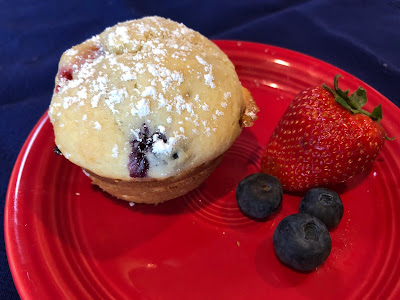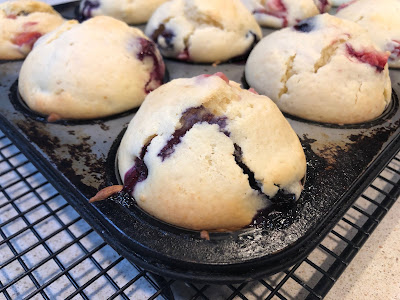
Recipe: Ricotta muffins feature strawberries and blueberries
 |
| This muffin is a great use for fresh summer fruit. (Photos: Kathy Morrison) |
Fresh local fruit is so wonderful in baked goods. I'm always looking for new ways to feature it, especially in quick recipes that don't require much time in the kitchen on warming-to-hot day. That's why I like baking for breakfast or weekend brunch: I'm done long before the temps are unbearable.
This recipe, adapted from "Bake From Scratch: Volume 3," by Brian Hart Hoffman, gives a fruit muffin an intriguing tang by including ricotta cheese. I've used strawberries and blueberries here because that's what I had on hand, but I could see it working just as well with blackberries, cherries or the peaches that are just coming to market.
Note: This makes a lot of batter. I chose to bake 12 extra-large muffins in a regular muffin pan, but you could use two pans to make about 16 regular-size muffins, or put the extra in a mini-muffin pan for snack-size muffins.
Ricotta muffins with fruit
Makes 16 regular or 12 extra-large muffins
Ingredients:
2-1/4 cups unbleached all-purpose flour
3/4 cup granulated sugar
2 teaspoons baking powder
1/2 teaspoon salt
1 cup ricotta cheese (whole-milk or low-fat)
2 large eggs
2/3 cup whole milk
1/4 cup canola or other neutral vegetable oil
2 teaspoons vanilla extract
3/4 cup diced fresh strawberries
3/4 cup fresh blueberries, checked for stems, washed and gently dried
Confectioners' sugar, for finishing
Instructions :
Preheat oven to 350 degrees. Prepare the muffin pan(s), either by spraying with cooking spray or lining with paper liners.
Combine in a large bowl the flour, sugar, baking powder and salt. Set aside.
 |
| These muffins are done, even though they're hardly brown at all. |
In a medium bowl or large glass measuring cup, stir together the ricotta and eggs, then add the milk. Stir in the oil and the vanilla extract.
Add the ricotta mixture to the flour mixture, stirring with a wooden spoon or flexible spatula until just combined. Gently fold in the prepared fruit.
Divide the batter among the prepared cups. Bake until a wooden pick inserted in the center comes out clean, about 20 minutes for regular-size muffins or 25 minutes for larger ones.
Note: The muffins do not brown much, if at all, so don't use their color as an indication of doneness.
Remove muffins from oven and allow to cool 10 minutes. Garnish with confectioners' sugar before serving. Store any leftover muffins covered, in the refrigerator. (They reheat well in the microwave.)
Variations:
Substitute 1-1/4 to 1-1/2 cups peeled diced peaches (pat fruit pieces with a paper towel if the peaches are very ripe) or pitted chopped cherries in place of the berries, and use a combination of 1 teaspoon almond extract and 1 teaspoon vanilla extract.
For blackberry muffins, use 1-1/4 cups washed fresh berries and 2 teaspoons vanilla extract. Stir in 1/2 teaspoon lemon or lime zest if desired.
Comments
0 comments have been posted.Sacramento Digs Gardening to your inbox.
Food in My Back Yard Series
May 6: Maintain soil moisture with mulch for garden success
April 29: What's (already) wrong with my tomato plants?
April 22: Should you stock up on fertilizer? (Yes!)
April 15: Grow culinary herbs in containers
April 8: When to plant summer vegetables
April 1: Don't be fooled by these garden myths
March 25: Fertilizer tips: How to 'feed' your vegetables for healthy growth
March 18: Time to give vegetable seedlings some more space
March 11: Ways to win the fight against weeds
March 4: Potatoes from the garden
Feb. 25: Plant a fruit tree now -- for later
Feb. 18: How to squeeze more food into less space
Feb. 11: When to plant? Consider staggering your transplants
Feb. 4: Starting in seed starting
Sites We Like
Garden Checklist for week of May 11
Make the most of the lower temperatures early in the week. We’ll be back in the 80s by Thursday.
* Plant, plant, plant! It’s prime planting season in the Sacramento area. Time to set out those tomato transplants along with peppers and eggplants. Pinch off any flowers on new transplants to make them concentrate on establishing roots instead of setting premature fruit.
* Direct-seed melons, cucumbers, summer squash, corn, radishes, pumpkins and annual herbs such as basil.
* Harvest cabbage, lettuce, peas and green onions.
* In the flower garden, direct-seed sunflowers, cosmos, salvia, zinnias, marigolds, celosia and asters. (You also can transplant seedlings for many of the same flowers.)
* Plant dahlia tubers.
* Transplant petunias, marigolds and perennial flowers such as astilbe, columbine, coneflowers, coreopsis, dahlias, rudbeckia and verbena.
* Keep an eye out for slugs, snails, earwigs and aphids that want to dine on tender new growth.
* Feed summer bloomers with a balanced fertilizer.
* For continued bloom, cut off spent flowers on roses as well as other flowering plants.
* Add mulch to the garden to maintain moisture. Mulch also cuts down on weeds. But don’t let it mound around the stems or trunks of trees or shrubs. Leave about a 6-inch-to-1-foot circle to avoid crown rot or other problems.
* Remember to weed! Pull those nasties before they set seed.
* Water early in the day and keep seedlings evenly moist.